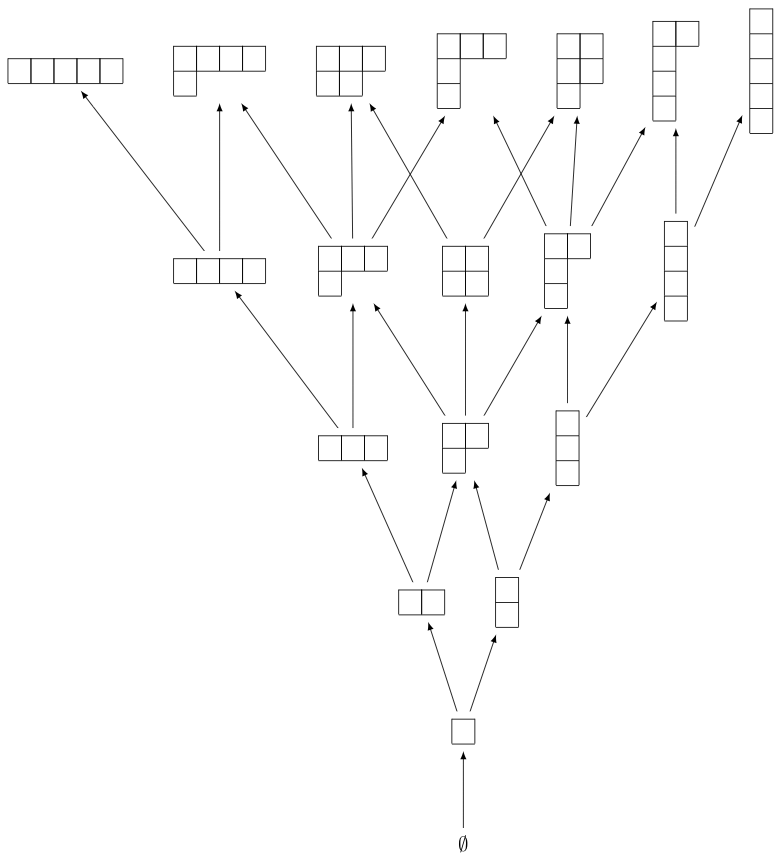This section provides some examples on the RSK algorithm explained in Chapter 8 of Stanley’s book [Stanley2013].
We begin by creating the first few levels of Young’s lattice \(Y\). For we need to define the elements and the order relation for the poset, which is containment of partitions:
sage: level = 6
sage: elements = [b for n in range(level) for b in Partitions(n)]
sage: ord = lambda x,y: y.contains(x)
sage: Y = Poset((elements,ord), facade=True)
sage: H = Y.hasse_diagram()
sage: view(H) # optional

We can now define the up and down operators on \(\QQ Y\). First we do so on partitions:
sage: QQY = CombinatorialFreeModule(QQ,elements)
sage: def up_operator_on_partitions(la):
....: covers = Y.upper_covers(la)
....: return sum(QQY(c) for c in covers)
sage: def down_operator_on_partitions(la):
....: covers = Y.lower_covers(la)
....: return sum(QQY(c) for c in covers)
Here is the result when we apply the operators to the partition \((2,1)\):
sage: la = Partition([2,1])
sage: up_operator_on_partitions(la)
B[[2, 1, 1]] + B[[2, 2]] + B[[3, 1]]
sage: down_operator_on_partitions(la)
B[[1, 1]] + B[[2]]
Now we define the up and down operator on \(\QQ Y\):
sage: def up_operator(b):
....: return sum(b.coefficient(p)*up_operator_on_partitions(p) for p in b.support())
sage: def down_operator(b):
....: return sum(b.coefficient(p)*down_operator_on_partitions(p) for p in b.support())
We can check the identity \(D_{i+1} U_i - U_{i-1} D_i = I_i\) explicitly on all partitions of 3 (so that \(i=3\)):
sage: for p in Partitions(3):
....: b = QQY(p)
....: assert down_operator(up_operator(b)) - up_operator(down_operator(b)) == b
....:
We can also check that the coefficient of \(\lambda \vdash n\) in \(U^n(\emptyset)\) is equal to the number of standard Young tableaux of shape \(\lambda\):
sage: u = QQY(Partition([]))
sage: for i in range(4):
....: u = up_operator(u)
....:
sage: u
B[[1, 1, 1, 1]] + 3*B[[2, 1, 1]] + 2*B[[2, 2]] + 3*B[[3, 1]] + B[[4]]
For example, the number of standard Young tableaux of shape \((2,1,1)\) is 3:
sage: StandardTableaux([2,1,1]).cardinality()
3
We can test this in general:
sage: for la in u.support():
....: assert u[la] == StandardTableaux(la).cardinality()
....:
Let us now turn to the RSK algorithm. If we want to verify Example 8.12, we can do so as follows:
sage: p = Permutation([4,2,7,3,6,1,5])
sage: p.robinson_schensted()
[[[1, 3, 5], [2, 6], [4, 7]], [[1, 3, 5], [2, 4], [6, 7]]]
The tableaux can also be displayed as tableaux:
sage: P,Q = p.robinson_schensted()
sage: P.pp()
1 3 5
2 6
4 7
sage: Q.pp()
1 3 5
2 4
6 7
The inverse RSK algorithm is also implemented:
sage: RSK_inverse(P,Q, output='word')
word: 4273615